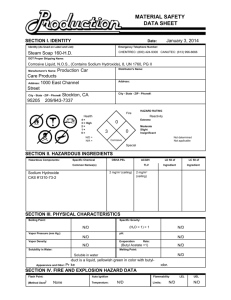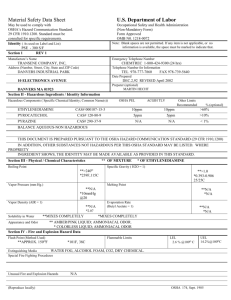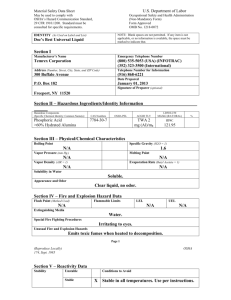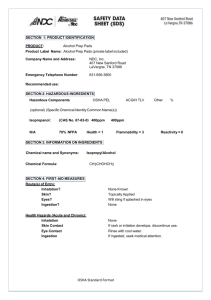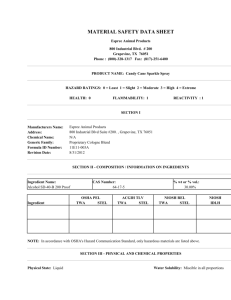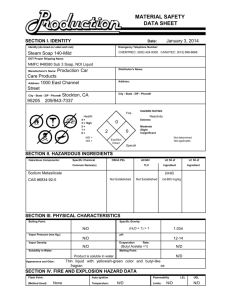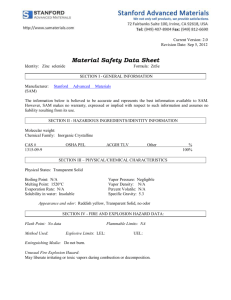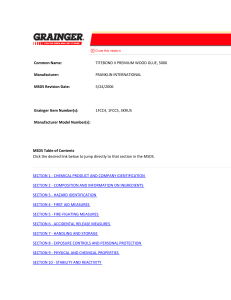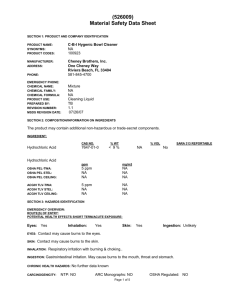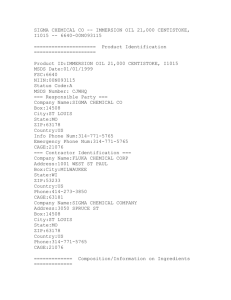Phase I - Production Car Care Products
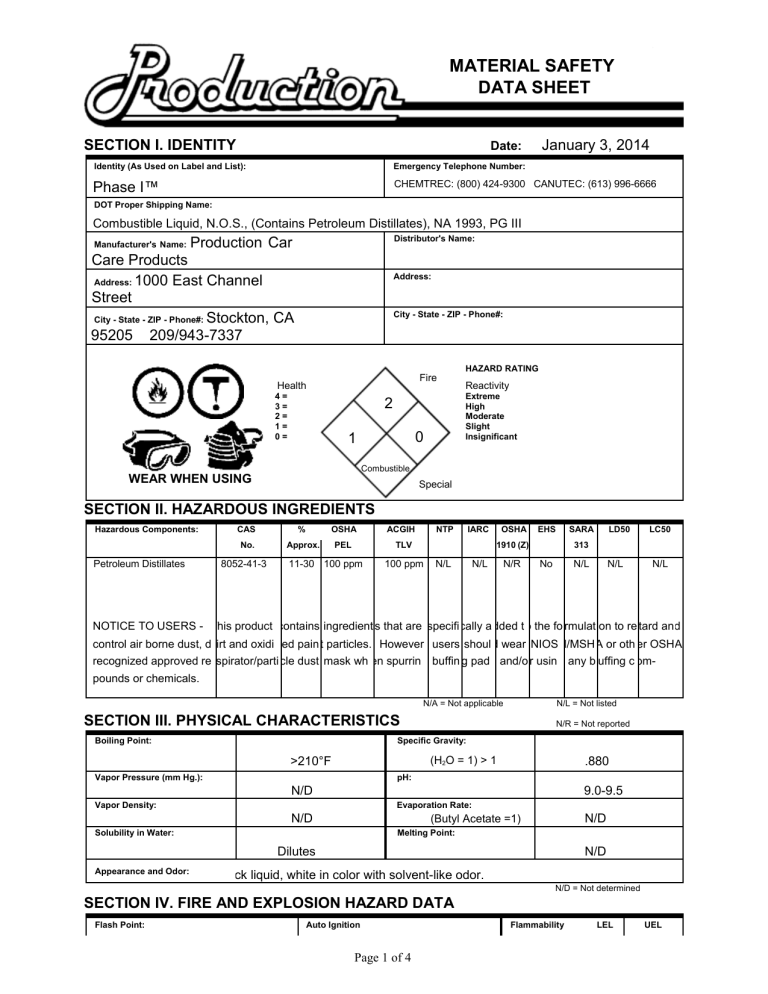
MATERIAL SAFETY
DATA SHEET
SECTION I. IDENTITY
Identity (As Used on Label and List):
Date:
January 3, 2014
Emergency Telephone Number:
CHEMTREC: (800) 424-9300 CANUTEC: (613) 996-6666
Phase I™
DOT Proper Shipping Name:
Combustible Liquid, N.O.S., (Contains Petroleum Distillates), NA 1993, PG III
Manufacturer's Name:
Production Car
Distributor's Name:
Care Products
Address:
Address:
1000 East Channel
Street
City - State - ZIP - Phone#:
City - State - ZIP - Phone#:
Stockton, CA
95205 209/943-7337
Health
4 =
3 =
2 =
1 =
0 =
2
Fire
HAZARD RATING
Reactivity
Extreme
High
Moderate
Slight
Insignificant
1 0
WEAR WHEN USING
Combustible
Special
SECTION II. HAZARDOUS INGREDIENTS
Hazardous Components:
Petroleum Distillates
CAS % OSHA ACGIH NTP IARC OSHA EHS SARA LD50 LC50
No.
Approx.
PEL TLV 1910 (Z) 313
8052-41-3 11-30 100 ppm 100 ppm N/L N/L N/R No N/L N/L N/L
NOTICE TO USERS - This product contains ingredient s that are specifi cally a dded t o the fo rmulat ion to re tard an d control air borne dust, d irt and oxidi zed pain t particles.
However , users shoul d wear NIOS H/MSH A or oth er OSH recognized approved re spirator/parti cle dust mask wh en spurrin g buffin g pad s and/o r usin g any b uffing c om-
A pounds or chemicals.
N/L = Not listed
N/R = Not reported
SECTION III. PHYSICAL CHARACTERISTICS
Boiling Point:
N/A = Not applicable
Specific Gravity:
Vapor Pressure (mm Hg.):
>210°F (H
2
O = 1) > 1
N/D pH:
Vapor Density:
Solubility in Water:
N/D
Evaporation Rate:
(Butyl Acetate =1)
Melting Point:
Dilutes
Appearance and Odor:
Thick liquid, white in color with solvent-like odor.
.880
9.0-9.5
N/D
N/D
N/D = Not determined
SECTION IV. FIRE AND EXPLOSION HAZARD DATA
Flash Point: Auto Ignition Flammability LEL UEL
Page 1 of 4
(Method Used)
119 ° F (TCC)
Extinguishing Media:
Temperature:
N/D
Fire Fighting Procedures:
Regular foam, carbon dioxide or dry chemical
Use self-contained breathing apparatus
Unusual Fire and
Explosion Hazards:
Vapor may travel
Limits:
N/D N/D
SECTION V. REACTIVITY DATA
N/D = Not determined
Phase I
Stable: X Unstable: Condition to Avoid:
Hazardous Decomposition or By-products:
Carbon Dioxide, Carbon Monoxide
Incompatibility (Materials to Avoid):
Strong Oxidizing Agents
Polymerization Hazard: May Occur Conditions to Avoid:
Will Not Occur
X
Heat or Flame
SECTION VI. HEALTH HAZARD DATA
Routes of
Entry:
Inhalation:
Yes
Skin:
Yes
Ingestion:
Yes
Health Hazards: Over Exposure - Eyes: irritation. Skin: moderate irritation. Breathing: dizziness, nausea,
(Acute and Chronic) headache. Ingestion: nausea, vomiting, diarrhea.
Additional Carcinogenicity
Information (If Any):
None Known
Signs and Symptoms of Exposure:
Medical Conditions That
May Be Aggravated by Exposure:
Irritation of Eyes, Skin & Throat
Poor General Health
Emergency and First Aid Procedures:
1) Eyes: Flush with water for at least 15 minutes. 2) Ingestion: Do not induce vomiting.
3) Breathing: Remove to fresh air 4) Skin: Wash with soap and water (CALL DOCTOR
FOR 1, 2 and 3)
SECTION VII. EMERGENCY RESPONSE PROCEDURES
Container Size: X 5 Gal. or Less 55 Gal. or Less Bulk Other:
Steps to be Taken If Material Is Released or Spilled
STEP 1. Human Health Protection: STEP 2. Containment and Control:
Avoid using in closed area
STEP 3. Decontamination:
Absorb with sand or absorbent material
STEP 4. Hazardous Waste Packaging/Shipping Requirements:
Prevent runoff to sewer or surface water
Waste Disposal Method:
In accordance with Local, State and Federal Regulations
SECTION VIII. SPECIAL PRECAUTIONS
Precautions to be Taken in Handling and Storing:
Keep product closed - Store away from heat or flame
Other Precautions:
Keep out of reach of children - Handle as a combustible liquid.
SECTION IX. CONTROL MEASURES
Page 2 of 4
Respiratory Protection: respirator/particle dust mask.
Ventilation
Local Exhaust:
OK
Mechanical:
Preferred
Protective Gloves:
Normally not needed
Should wear NIOSH/MSHA or other OSHA recognized approved
Special:
None
Other:
None
Eye Protection:
Safety spectacles
Other Protective Clothing or Equipment:
Should wear NIOSH/MSHA or other OSHA recognized approved respirator/particle dust mask
Work/Hygienic Practices:
No eating, drinking or smoking. Wash up after use.
Disclaimer of Liability
The information contained herein is based on data considered accurate. However, the information is provided without any warranty, expressed or implied, regarding its correctness. The conditions or methods of handling, storage, use and disposal of the product are be yond our control and may be beyond our knowledge. For this and other reasons, we do not assume responsibility for personal injury or property damage to vendees, users or third parties caused by the material. We also do not assume responsibility and expressly disclaim liability for loss, damage or expense arising out of or in any way connected with the handling, storage, use or disposal of the product.
Phase I
MATERIAL SAFETY
DATA SHEET
SECTION X. HAZARDOUS INGREDIENT DEFINITION
A Hazardous Ingredient Is One Which
Meets One Or More Of The Following Criteria:
1. It is listed in the annual registry of toxic effects of chemical substances, or is known to be toxic within the parameters of that registry, and is present at a level of 1% or greater of the composition, except that chemicals identified as carcinogens under 20 CFR 1919.1200 (d)(4) shall be listed if the concentrations are 0.1% or greater.
2. It has an OSHA established Permissible Exposure Limits or Ceiling Concentration (C) or an
American Conference of Governmental Industrial Hygienists (ACGIH) TLV or C and by the nature of the product or its known use, is likely to become airborne.
3. It contributes to one or more of the following hazards to the product: A. Any liquid having a flash point of not more than 141°F.
B. Causes full thickness destruction of human skin at the site of contact within a specified period of time. (DOT)
C. A material that may, generally be yielding oxygen, cause or enhance the combustion of other materials. (DOT)
D. Subject to hazardous polymerization.
Each hazardous ingredient should be listed by chemical, generic or proprietary name, its level in the product should be expressed as 1% or less, 1-10%, 11-30%, 31-50%,51-70%, or greater than
70%, or by other means if such information is proprietary. Recommended ACGIH or registry of toxic effects of chemical substances TLV or C values are only listed with appropriate notation, where
OSHA values are not available.
Definitions:
OSHA: Occupational Safety and Health Administration
Page 3 of 4
PEL: Permissible Exposure Limit
ACGIH: American Conference of Governmental Industrial Hygienists
TLV: Threshold Limit Value
NTP: National Toxicology Program
IARC: International Agency for Research or Cancer Monograph
EHS: Extremely Hazardous Substances
SARA: Superfund Amendments and Reauthorization Act
LD: Lethal Dose
LC: Lethal Concentration
Disclaimer of Liability
The information contained herein is based on data considered accurate. However, the information is provided without any warranty, expressed or implied, regarding its correctness. The conditions or methods of handling, storage, use and disposal of the product are beyond our control and may be beyond our knowledge. For this and other reasons, we do not assume responsibility for personal injury or property damage to vendees, users or third parties caused by the material. We also do not assume responsibility and expressly disclaim liability for loss, damage or expense arising out of or in any way connected with the handling, storage, use or disposal of the product.
Page 4 of 4
